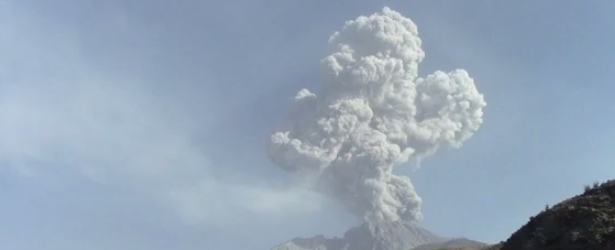Activity intensifies at Ubinas volcano, Peru

Near-constant small to moderate explosions and ash emissions continue at Ubinas, most active volcano of Peru. As activity intensifies authorities are considering raising the alert level to orange after which the local communities will have to be evacuated.
Orlando Macedo, head of the Volcanology Geophysical Institute of Peru (IGP) said that eruption on April 15th, which spewed ash up to 4.8 km, was the strongest since 2006.
The regional president of Moquegua, Martin Vizcarra, estimated that activity at Ubinas already affected about 5000 people and added that about 20 000 people could be affected.
The volcano has been active again since September 2013 when it erupted at least seven times. On September 13 officials declared state of emergency for nine nearby districts. The explosions have sent a plume of smoke rising to about 2.5 km above the crater.
Seismicity significantly increased again on March 29, 2014 with energetic tremor, indicating magma ascent and degassing, and small explosions.
On April 2 harmonic tremor was detected. Gas-and-ash plumes rose 0.9 – 2.2 km above the crater and drifted SE and E. Minor ashfall was reported in Tonohaya (7 km SSE), San Miguel, and Ubinas (6.5 km SSE). Based on webcam views, the Buenos Aires VAAC reported that on April 3 gas-and-steam plumes possibly containing ash rose 6.1 – 7.3 km (20 000 – 24 000 ft) a.s.l. and dissipated around the crater.
IGP's Observatorio Volcanologico Arequipa (IGP-OVA) and Volcanological Observatory del INGEMMET (OVI) reported that during April 9 – 14 seismicity at Ubinas remained high. Gas-and-ash plumes rose 0.3 – 2.2 km above the crater and drifted mostly E, SE, and S. Ashfall was Reported in Ubinas (6.5 miles SSE), Huatagua (14 km SE), Anascapa (11 km SE), Tonohaya (7 km SSE), San Miguel (10 km SE), Sacuaya, Querapi (4 km S), San Juan de Tarucani, Escacha, Ichuña, Yungas, and Chojata.
On April 13 a significant explosion occurred that possibly removed the body of recently erupted lava on the crater floor; incandescent tephra was ejected from the crater. On April 14 an explosion ejected incandescent tephra from the crater that was deposited on the W flank.
INGEMMET volcanologists climbed the volcano on April 15 and observed that the recent explosive activity had destroyed the small lava dome in its summit crater, a deep pit crater could be seen at its place.

Video courtesy of Diario Correo
The following video was recorded on April 16, 2014:


Video courtesy of INGEMMET AQP
Geologic summary
A small, 1.4-km-wide caldera cuts the top of Ubinas, Peru's most active volcano, giving it a truncated appearance. Ubinas is the northernmost of three young volcanoes located along a regional structural lineament about 50 km behind the main volcanic front of Perú. The growth and destruction of Ubinas I volcano was followed by construction of Ubinas II volcano beginning in the mid-Pleistocene. The upper slopes of the andesitic-to-rhyolitic Ubinas II stratovolcano are composed primarily of andesitic and trachyandesitic lava flows and steepen to nearly 45 degrees.
The steep-walled, 150-m-deep summit caldera contains an ash cone with a 500-m-wide funnel-shaped vent that is 200 m deep. Debris-avalanche deposits from the collapse of the SE flank of Ubinas about 3700 years ago extend 10 km from the volcano. Widespread plinian pumice-fall deposits from Ubinas include one of Holocene age about 1000 years ago. Holocene lava flows are visible on the volcano's flanks, but historical activity, documented since the 16th century, has consisted of intermittent minor-to-moderate explosive eruptions. (GVP)
Eruptions at Ubinas have been reported since 1550.
Featured image courtesy of INGEMMET AQP – April 16, 2014.

Commenting rules and guidelines
We value the thoughts and opinions of our readers and welcome healthy discussions on our website. In order to maintain a respectful and positive community, we ask that all commenters follow these rules:
We reserve the right to remove any comments that violate these rules. By commenting on our website, you agree to abide by these guidelines. Thank you for helping to create a positive and welcoming environment for all.